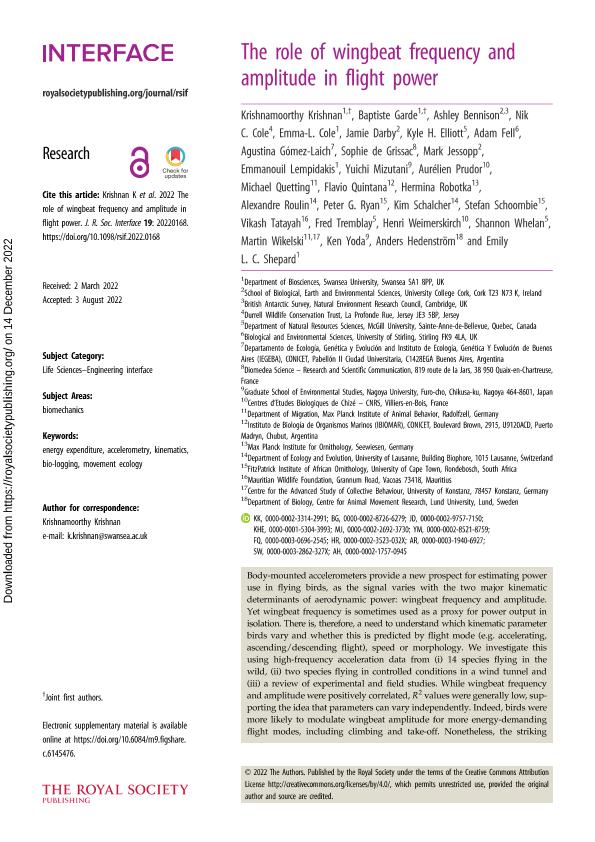Artículo
The role of wingbeat frequency and amplitude in flight power
Krishnan, Krishnamoorthy; Garde, Baptiste; Bennison, Ashley; Cole, Nik C.; Cole, Emma L.; Darby, Jamie; Elliott, Kyle H.; Fell, Adam; Gómez Laich, Agustina Marta ; de Grissac, Sophie; Jessopp, Mark; Lempidakis, Emmanouil; Mizutani, Yuichi; Prudor, Aurélien; Quetting, Michael; Quintana, Flavio Roberto
; de Grissac, Sophie; Jessopp, Mark; Lempidakis, Emmanouil; Mizutani, Yuichi; Prudor, Aurélien; Quetting, Michael; Quintana, Flavio Roberto ; Robotka, Hermina; Roulin, Alexandre; Ryan, Peter G.; Schalcher, Kim; Schoombie, Stefan; Tatayah, Vikash; Tremblay, Fred; Weimerskirch, Henri; Whelan, Shannon; Wikelski, Martin; Yoda, Ken; Hedenström, Anders; Shepard, Emily L. C.
; Robotka, Hermina; Roulin, Alexandre; Ryan, Peter G.; Schalcher, Kim; Schoombie, Stefan; Tatayah, Vikash; Tremblay, Fred; Weimerskirch, Henri; Whelan, Shannon; Wikelski, Martin; Yoda, Ken; Hedenström, Anders; Shepard, Emily L. C.
 ; de Grissac, Sophie; Jessopp, Mark; Lempidakis, Emmanouil; Mizutani, Yuichi; Prudor, Aurélien; Quetting, Michael; Quintana, Flavio Roberto
; de Grissac, Sophie; Jessopp, Mark; Lempidakis, Emmanouil; Mizutani, Yuichi; Prudor, Aurélien; Quetting, Michael; Quintana, Flavio Roberto ; Robotka, Hermina; Roulin, Alexandre; Ryan, Peter G.; Schalcher, Kim; Schoombie, Stefan; Tatayah, Vikash; Tremblay, Fred; Weimerskirch, Henri; Whelan, Shannon; Wikelski, Martin; Yoda, Ken; Hedenström, Anders; Shepard, Emily L. C.
; Robotka, Hermina; Roulin, Alexandre; Ryan, Peter G.; Schalcher, Kim; Schoombie, Stefan; Tatayah, Vikash; Tremblay, Fred; Weimerskirch, Henri; Whelan, Shannon; Wikelski, Martin; Yoda, Ken; Hedenström, Anders; Shepard, Emily L. C.
Fecha de publicación:
08/2022
Editorial:
The Royal Society
Revista:
Journal of the Royal Society Interface
ISSN:
1742-5689
Idioma:
Inglés
Tipo de recurso:
Artículo publicado
Clasificación temática:
Resumen
Body-mounted accelerometers provide a new prospect for estimating power use in flying birds, as the signal varies with the two major kinematic determinants of aerodynamic power: wingbeat frequency and amplitude. Yet wingbeat frequency is sometimes used as a proxy for power output in isolation. There is, therefore, a need to understand which kinematic parameter birds vary and whether this is predicted by flight mode (e.g. accelerating, ascending/descending flight), speed or morphology. We investigate this using high-frequency acceleration data from (i) 14 species flying in the wild, (ii) two species flying in controlled conditions in a wind tunnel and (iii) a review of experimental and field studies. While wingbeat frequency and amplitude were positively correlated, R 2 values were generally low, supporting the idea that parameters can vary independently. Indeed, birds were more likely to modulate wingbeat amplitude for more energy-demanding flight modes, including climbing and take-off. Nonetheless, the striking variability, even within species and flight types, highlights the complexity of describing the kinematic relationships, which appear sensitive to both the biological and physical context. Notwithstanding this, acceleration metrics that incorporate both kinematic parameters should be more robust proxies for power than wingbeat frequency alone.
Palabras clave:
ACCELEROMETRY
,
BIO-LOGGING
,
ENERGY EXPENDITURE
,
KINEMATICS
,
MOVEMENT ECOLOGY
Archivos asociados
Licencia
Identificadores
Colecciones
Articulos(IBIOMAR)
Articulos de INSTITUTO DE BIOLOGIA DE ORGANISMOS MARINOS
Articulos de INSTITUTO DE BIOLOGIA DE ORGANISMOS MARINOS
Articulos(IEGEBA)
Articulos de INSTITUTO DE ECOLOGIA, GENETICA Y EVOLUCION DE BS. AS
Articulos de INSTITUTO DE ECOLOGIA, GENETICA Y EVOLUCION DE BS. AS
Citación
Krishnan, Krishnamoorthy; Garde, Baptiste; Bennison, Ashley; Cole, Nik C.; Cole, Emma L.; et al.; The role of wingbeat frequency and amplitude in flight power; The Royal Society; Journal of the Royal Society Interface; 19; 193; 8-2022; 1-15
Compartir
Altmétricas



